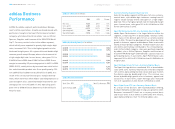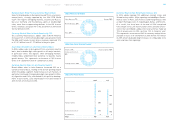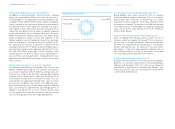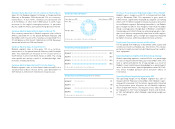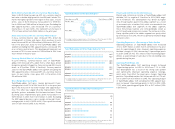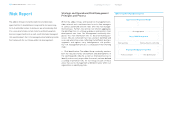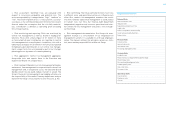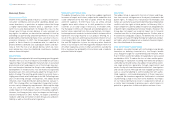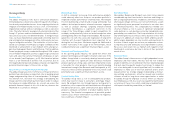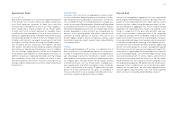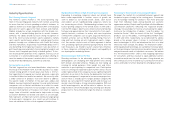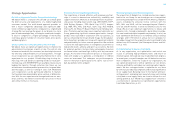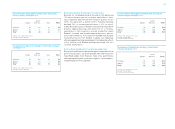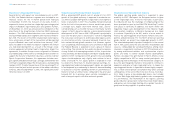Reebok 2006 Annual Report Download - page 102
Download and view the complete annual report
Please find page 102 of the 2006 Reebok annual report below. You can navigate through the pages in the report by either clicking on the pages listed below, or by using the keyword search tool below to find specific information within the annual report.Group Management Report ›
External Risks
Macroeconomic Risks
Growth of the sporting goods industry is closely correlated to
consumer confidence and consumer spending. Abrupt eco-
nomic downturns, in particular in regions where the Group
is highly represented, therefore pose a significant short-
term risk to sales development. To mitigate this risk, it is the
Group’s goal to have an even balance of sales amongst our
key regions. In addition, we have further reduced this risk by
extending our partnership and event portfolio to increase the
predictability of demand and make it less sensitive to macro-
economic influence. In 2007, the Group expects economic
growth in North America to moderate due to a decline in
private domestic demand (see Subsequent Events and Out-
look, p. 106). The risk of an abrupt decline, which we, how-
ever, believe has only a low likelihood, could have a medium
adverse financial impact.
Industry Risks
Price pressure and product discounting among sporting goods
retailers often as a result of industry consolidation can have a
negative impact on sporting goods manufacturers. A sustained
promotional retail landscape in one of the Group’s key mar-
kets can therefore threaten the Group’s sales and profitability
development. To moderate this risk, we maintain a regionally
balanced sales mix and continually adapt the Group’s distri-
bution strategy. The sporting goods industry currently faces a
highly promotional retail landscape in the UK. Following three
years of declining average selling prices, the adidas brand
initiated a new trade distribution policy effective January 1,
2007. This strategy offers our top product range only to retail-
ers who satisfy trade policy requirements. We accept the high
risk of a short-term sales loss, which we expect to have a
visible impact on the European results of the adidas segment.
However, the Group projects only a low impact on the Group’s
overall contribution in 2007. Further, we expect a beneficial
medium- and long-term effect on both Group sales and prof-
itability as well as the UK market in general.
Regulatory and Political Risks
The adidas Group faces risks arising from sudden significant
increases of import restrictions, import tariffs and duties that
could compromise the free flow of goods within the Group
and from suppliers. To limit these risks, we utilize a broad
supplier base which allows us to shift production to other
countries at an early stage if necessary. In October 2006,
the European Commission imposed anti-dumping duties on
leather shoes imported from China and Vietnam. An impor-
tant exception was made for technical athletic footwear which
represents the large majority of our product offering. As a
result of this decision and the proactive diversification of our
sourcing portfolio (see Global Operations, p. 60), we expect
the new EU legislation to have an only very minor financial
effect on our Group in 2007. We regard the medium-term risk
of further regulatory actions in other jurisdictions outside the
EU as having a low probability of occurrence and a medium
potential financial impact.
Legal Risks
The adidas Group is exposed to the risk of claims and litiga-
tion from serious infringement of third party trademark and
patent rights. To reduce risk, new product technologies and
names are carefully researched to identify and avoid potential
conflicts with the rights of third parties. In February 2006, a
major competitor sued the adidas Group for an alleged breach
of patent rights regarding two footwear models. However, the
Group does not expect any material impact on its financial
situation from this or other pending lawsuits. Further, due to
the extensive safeguards in place, we believe that the risk of
our Group seriously infringing third party trademark and pat-
ent rights, which could generate a medium financial impact,
has a low likelihood of occurrence.
Risks from Product Counterfeiting
As popular consumer brands with technological and design
innovation as defining characteristics, the Group’s brands
are a frequent target for counterfeiting and imitation. More
than 6 million counterfeit adidas Group products were seized
worldwide in 2006. To reduce the loss of sales and the poten-
tial damage of reputation resulting from defective products
sold under our brand names, the adidas Group utilizes exten-
sive legal protection (generally through registration) and
works closely with law enforcement authorities, investigators
and outside counsel. Although we have stepped up measures
such as security labeling to control production with autho-
rized suppliers, continued development of these measures
is required. We therefore regard the likelihood of sustained
counterfeiting as high in the short term. However, the impact
on our forecasted financial results is expected to remain at
a similar level compared to previous years, which means its
potential to generate a visible contribution variance is low.
› Risk Report
098 ANNUAL REPORT 2006 › adidas Group ›


